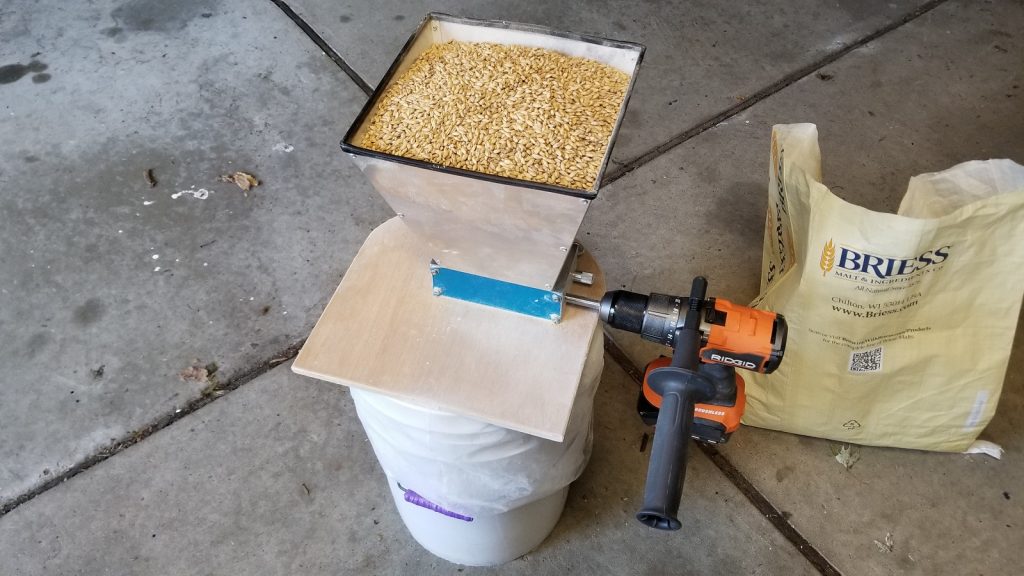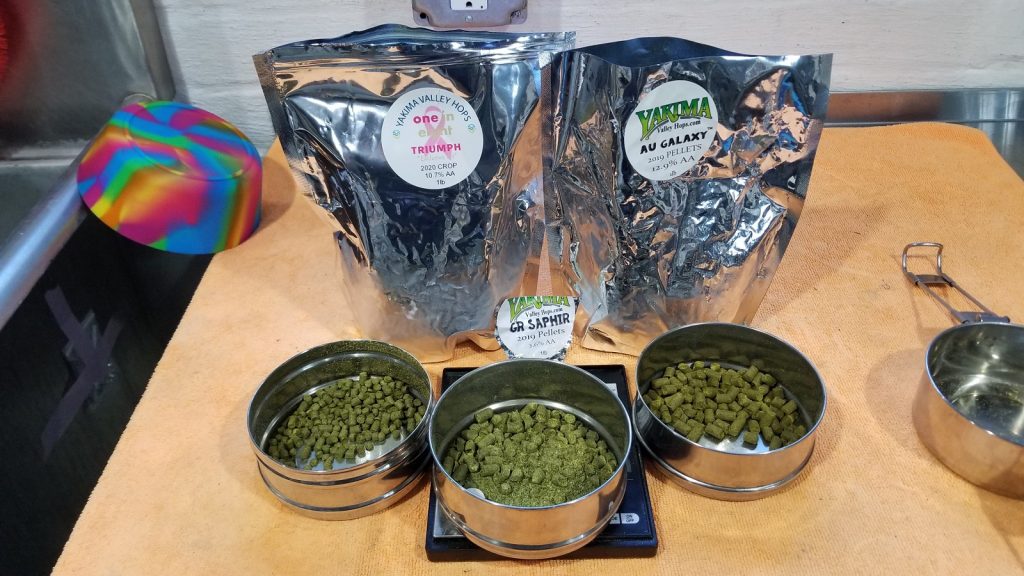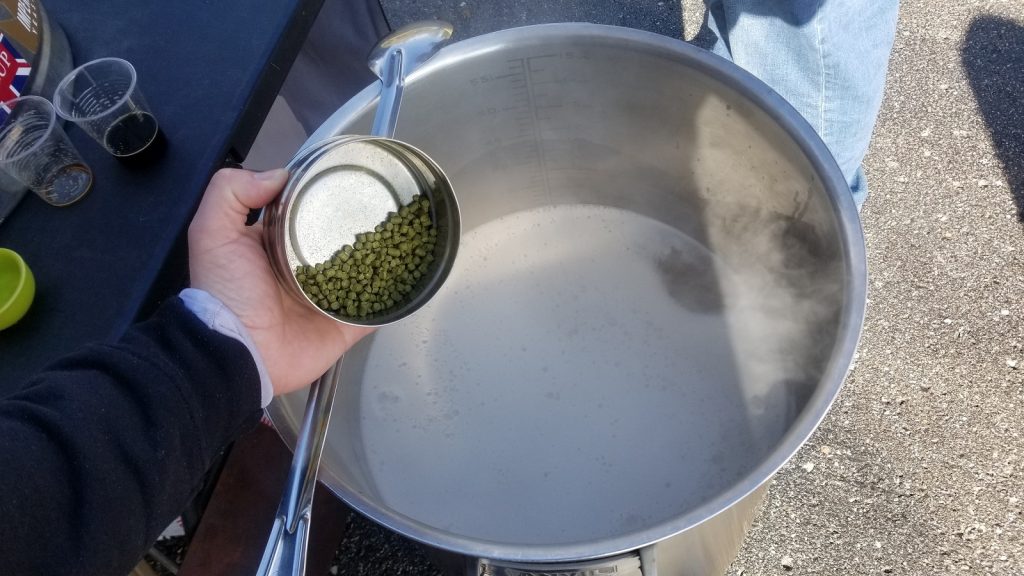Author: Mike Neville
One of my favorite things about being part of a homebrew club is getting to experience the myriad unique, creative, and sometimes weird recipes members come up with. What’s more fun is getting to hear the stories behind how one arrived at a particular recipe. Homebrewing gives us a chance to create whatever kind of beer we want, which is exactly what my good friend Dan Kukuk did with his Double Trouble, a Saison made with raspberry and hibiscus for friends of his who had just had twin girls.
In addition to having prior positive experiences with this combination, Dan’s decision to use raspberry and hibiscus was also influenced by the fact it featured two adjuncts (like twins) that would result in a pink beer. I’ve had many iterations of Double Trouble and, like the friends he originally brewed it for, have always really enjoyed it. In fact, we brewed this beer together on a past Big Brew Day and took second place in a people’s choice competition where we got to tell the beer’s origin story to tasters.
When deciding what to make for the latest Learn To Homebrew Day, I knew I wanted something a little different than the standard styles I had on tap and decided to make Dan’s delicious Double Trouble.
| Making Double Trouble Raspberry Hibiscus Saison |
Not one to fiddle with a good thing, I went with the latest iteration of Dan’s recipe for this batch.
Double Trouble Raspberry Hibiscus Saison
Recipe Details
| Batch Size | Boil Time | IBU | SRM | Est. OG | Est. FG | ABV |
|---|---|---|---|---|---|---|
| 5.8 gal | 60 min | 28.1 | 4.2 SRM | 1.062 | 1.006 | 7.35 % |
| Actuals | 1.062 | 1.006 | 7.35 % | |||
Fermentables
| Name | Amount | % |
|---|---|---|
| Pilsner 2-Row | 8.5 lbs | 65.38 |
| Vienna Malt | 2 lbs | 15.38 |
| Sugar, Table (Sucrose) | 1.5 lbs | 11.54 |
| White Wheat Malt | 1 lbs | 7.69 |
Hops
| Name | Amount | Time | Use | Form | Alpha % |
|---|---|---|---|---|---|
| Triumph | 21 g | 60 min | Boil | Pellet | 10.7 |
| Saphir | 28 g | 10 min | Boil | Pellet | 2.6 |
| Galaxy | 28 g | 4 days | Dry Hop | Pellet | 13.6 |
Miscs
| Name | Amount | Time | Use | Type |
|---|---|---|---|---|
| Hibiscus | 4 oz | 0 min | Primary | Herb |
| Raspberry | 5 lb | 0 min | Primary | Other |
Yeast
| Name | Lab | Attenuation | Temperature |
|---|---|---|---|
| Napoleon (B64) | Imperial Yeast | 83% | 32°F - 32°F |
Notes
| Water Profile: Ca 160 | Mg 17 | Na 8 | SO4 335 | Cl 92 |
Download
| Download this recipe's BeerXML file |
Prior to heading out to the 2021 Learn To Homebrew Day at Cadillac Straights Brewing Company and Supply House in Madison Heights, MI, I weighed out and milled the grain.
I also prepared the kettle hop additions.
Once on site, I collected the water, adjusted it to my desired profile, then heated it up before mashing in. Once the grains were fully incorporated, I checked to make sure it was at my target mash temperature.
When the 60 minute mash step was complete, I sparged to collect the proper volume of sweet wort then boiled it for an hour, adding hops at the times listed in the recipe.
Once the boil was finished, I quickly chilled the wort then took a refractometer reading showing it was at my target of 1.062 OG.

After racking the wort to my fermenter, I drove it home then pitched a pouch of Imperial Yeast B64 Napoleon.
The filled fermenter was placed in my chamber and left to ferment at 68°F/20°C for 5 days before warming things up to 72°F/22°C. After 4 more days, I prepared the raspberry and hibiscus.
Wanting to ensure a clean packaging process, I placed both adjuncts in a sanitized 5 gallon paint strainer bag then gently added it to the beer before purging the fermenter afterwards to reduce the risk of oxidation.
I added the dry hop addition 5 days later then let the beer sit another 4 days with the hope any sugars contributed by the raspberry would be consumed by the yeast. A hydrometer measurement taken at this time showed the beer was at a pleasantly dry 1.003 FG.

I cold-crashed the beer overnight before pressure transferring it to a CO2 purged keg.
The filled keg was placed in my keezer and burst carbonated overnight before I reduced the gas to serving pressure. After a couple weeks of conditioning, it was nicely carbonated and looking rather beautiful.
| IMPRESSIONS |
There’s nothing novel about adding fruit and spice to beer, though in my opinion, the key to great examples is finding the right combination of style and adjuncts, which is precisely what Double Trouble does. The subtle peppery phenols from the B64 Napolean yeast provide a perfect canvass for the earthy raspberry and tart hibiscus, which is further brought to life by the peppy carbonation of this beer. Despite boasting over 7% ABV, any alcohol warmth is covered up by the raspeberry and hibiscus, making this incredibly refreshing and easy to drink.
While this beer was on tap, I learned Dan also had a keg of Double Trouble flowing at his place, so we connected for a comparison session. Likely due to our individual “brewer’s thumbprints,” we both noticed slight differences between the beers—whereas the flowery hibiscus was more prominent in mine, Dan’s version was slightly more fruit-forward. Still, they were far more similar than they were different, and both were delicious. I’m beyond happy with this recipe, though in the future I think it’d be cool to swap the Galaxy dry hop addition for something like Sabro to add an interesting coconut twist.
If you have thoughts about this recipe or experience making something similar, please feel free to share in the comments section below!
Support Brülosophy In Style!
All designs are available in various colors and sizes on Amazon!
Follow Brülosophy on:
FACEBOOK | TWITTER | INSTAGRAM
If you enjoy this stuff and feel compelled to support Brulosophy.com, please check out the Support page for details on how you can very easily do so. Thanks!






















22 thoughts on “Brü It Yourself | Double Trouble Raspberry Hibiscus Saison”
So Mike, did you blend the two versions to see if 1+1=Better?
Ya know, we didn’t. Can’t believe we didn’t think to try that.
Being a member of Mike and Dan’s brew club, the Motor City Mashers ( https://www.motorcitymashers.org – #cheapplug ), I’ve had this beer a few times. It’s a HUGE FAVORITE! I think that the Sabro suggestion might be a gamechanger!!!
Thanks Ray!
What lead to the low end final gravity or 1.003?
Likely a combination of the table sugar added in the boil and the Saison yeast; the B64 rips. I also allow the sugars added from the raspberries to ferment out before packaging. Because of the base style, I still want it to ferment out as much as possible, even with the fruit addition.
Any ideas for a substitute for the Triumph hops as I can’t seem to find them?
I’d probably suggest Nugget and/or Brewers Gold. According to Yakima Valley Hops website, Triumph is a decedent of those. Really, any hop that you would use as a bittering addition in a Saison would work well.
I recently did a single hop pale ale with Triumph, it has very strong orange flavor and aroma like fresh squeezed OJ. I would think a citrus forward hop like Mandarina Bavaria or maybe Amarillo may have some of the same character.
Thanks for the recipe! I brewed this over the weekend and ended up with an OG of 1.07, even after reducing the sugar to 1#. I plan to dry hop with 1oz each Galaxy and Sabro since I have both types.
Hey Cory – That’s awesome! Hopefully Cadillac Straights has their homebrew meetup for February – I’d love to try it with the Sabro addition!
Hey Cory, how did the sabro and galaxy work out? Planning on doing the same in a couple of days.
Saison is easily my favorite beer style and while I started reading this article with no intent of brewing this I am very intrigued now. My major gripe with a lot of commercial Saison is that it seems the term is just used for a fruited sour that has no Saison yeast character. I like that you didn’t pitch any Brett or bugs into this. I may have to give it a go when the weather starts to warm up!
Awesome, yeah no bugs in this one! Although, now you’ve intrigued me
Haha, yeah, don’t get me wrong, some lacto would be great in this! But I think the delicate esters and phenols from Saison yeast gets overshadowed by that. Maybe make a split batch and sour one of them.
Yeah I’d tend to agree; the Saison yeast character already takes a back seat to the raspberry and hibiscus is this one. Split batch is a great idea
That color is great and I think this would be an interesting candidate for contrasting taste tests where one group can see it and one tastes blind.
Amazing! My go to Saison on tap is a Honey & Hibiscus saison, while I just finished a Summer Cherry Saison which is on tap now. It’s such a great canvas for fruit flavors, especially those who side towards acidity
What’s up with this water profile? Is this unfiltered tap water or are you going for a specific regional profile?
I use unfiltered Detroit tap water. The profile is based off of the Brewfather’s Saison water profile.
This may be a dumb question, but does fermentation kick up again after the fruit addition? if so, do you loose the sweetness from the raspberries?
Not a dumb question at all. Yes, fermentation kicks back up on this one. After the raspberries are added, I let the beer sit at 72F for nine to ten days to encourage fermentation to dry the beer out. Being a Saison base style, I’m looking for a low finishing gravity. The sweetness is gone but you’re left with that raspberry flavor and tartness.